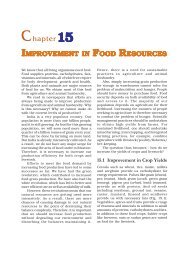C
Create successful ePaper yourself
Turn your PDF publications into a flip-book with our unique Google optimized e-Paper software.
The flexibility in plants is due to another<br />
permanent tissue, collenchyma. It allows<br />
easy bending in various parts of a plant (leaf,<br />
stem) without breaking. It also provides<br />
mechanical support to plants. We can find<br />
this tissue in leaf stalks below the epidermis.<br />
The cells of this tissue are living, elongated<br />
and irregularly thickened at the<br />
corners. There is very little intercellular<br />
space (Fig. 6.4 b).<br />
Intercellular spaces<br />
Wall thickenings<br />
Nucleus<br />
Vacuole<br />
Cell wall<br />
a (i)<br />
b (i)<br />
Cytoplasm<br />
Nucleus<br />
Middle lamella<br />
Chloroplast<br />
Vacuole<br />
Intercellular space<br />
Primary cell wall<br />
End wall<br />
Primary cell wall<br />
(thickened at corners)<br />
Chloroplast<br />
Nucleus<br />
Vacuole<br />
Cytoplasm<br />
Intercellular space<br />
a (ii)<br />
b (ii)<br />
Simple<br />
pit pair<br />
Narrow lumen<br />
Lignified<br />
thick wall<br />
c (i)<br />
c (ii)<br />
Fig. 6.4: Various types of simple tissues: (a) Parenchyma (i) transverse section, (ii) longitudinal section;<br />
(b) Collenchyma (i) transverse section, (ii) longitudinal section; (c) Sclerenchyma (i) transverse section,<br />
(ii) longitudinal section.<br />
TISSUES 71
















